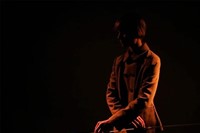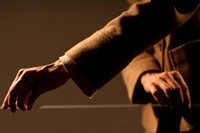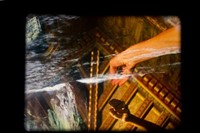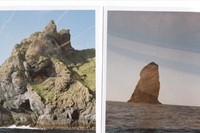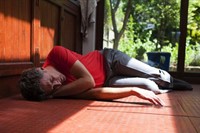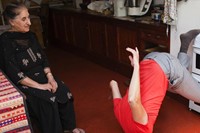For this exhibition renowned choreographer Siobhan Davies has paired up visual artists with dancers to create four works, encouraging the duos to step outside of their artistic comfort zones...
For this exhibition renowned choreographer Siobhan Davies has paired up visual artists with dancers to create four works, encouraging the duos to step outside of their artistic comfort zones. For their collaboration, A Dance of Ownership, A Song in Hand, Turner Prize-nominated artist Lucy Skaer and dance artist Gill Clarke have produced a double-exposed film which is viewed as part of an installation with a live performance and soundtrack.
In order to encourage a sense of shared experience, the two travelled to the remote island of St. Kilda in the Outer Hebrides. “We felt that leaving our normal surroundings and routines would be more productive to generating ideas and concentrating our conversation,” Skaer tells AnOther. Once there, they filmed a gesturing hand moving against the island’s rocky cliffs and the wild ocean below, then overlaid it with footage from Mount Stuart, the ancestral home of the Fifth Marquis of Bute, St Kilda’s previous owner. The result is a looped short film that is elegant and evocative, and full of traces. “The work exists in an area between first and second hand,” Skaer explains. “The film has been physically put through the camera twice and the sound is generated by manually pulling the magnetic tape through the tape heads. Though it was not our first interest to produce traces, it is inherent to recording, inhabited landscape, capturing time.”
“The live performance produces a replaying of recorded material in a conscious way,” Skaer continues, alluding to the two female dancers who are present in the gallery, manually manipulating tape to produce a distorted soundtrack. “If we had played just the film or the sound without the performers, I think the sense of new combination would have been lost.”
To begin their collaborative project, A Question of Movement, artist Marcus Coates and dancer Henry Montes posed the questions: Does dance have a practical function? Can it be made relevant to people’s lives? “We wanted to test contemporary dance,” Coates tells us. “Traditional and folk dances all come from functional sources—to attract a mate, prepare for war or for fertility rites—and we wanted to tap into what performance can be in our society today.”
“There is a feeling that contemporary dance and movement as an art form can often be isolated or trapped within its own language,” says Coates. “It does not always have the opportunity to reach out and touch everyday life.”
To this end they interviewed members of the public, visiting individuals at work, in their kitchens and bedrooms, and asking them to pose a question that was heavy on their mind. Coates (the artist), then “danced” a response, aiming to provide insight or interpretation, while Montes (the dancer), stayed behind the camera, asking each person whether they felt Coates’ dance was relevant to their question, and encouraging them to give instructions on how he could refine his movements. People were surprisingly quick to act as choreographer, offering praise and criticism, and suggestions on how Coates could improve his performance. “We wanted to encourage people to be proactive,” Coates explains. “That's why we decided to switch. What I’m doing is so un-dance; it's just movement, which makes it easier for people to identify with than if it was Henry, the professional dancer, in front of them.“
By externalising their questions through movement and representing them in in a straightforward manner on film, Coates and Montes bring attention to how people’s complex internal lives carry on existing amongst the stuff of everyday life, showing that dance is indeed able to affect them on this day-to-day level. “There is a feeling that contemporary dance and movement as an art form can often be isolated or trapped within its own language,” says Coates. “It does not always have the opportunity to reach out and touch everyday life.”
Two other pieces, drawing series What Isn’t Here Hasn’t Happened Yet, by Sarah Warsop and Tracey Rowledge, and installation, live performance and sound design LandMark, by Deborah Saxon, Henry Montes and Bruce Sharp, also continue as part of the Siobhan Daives Commissions at the Bargehouse until Sunday 13 November, 2011. Free entry.
Text by Ananda Pellerin
Ananda Pellerin is a London-based writer and Neil Wissink is a visual artist also based in London.
